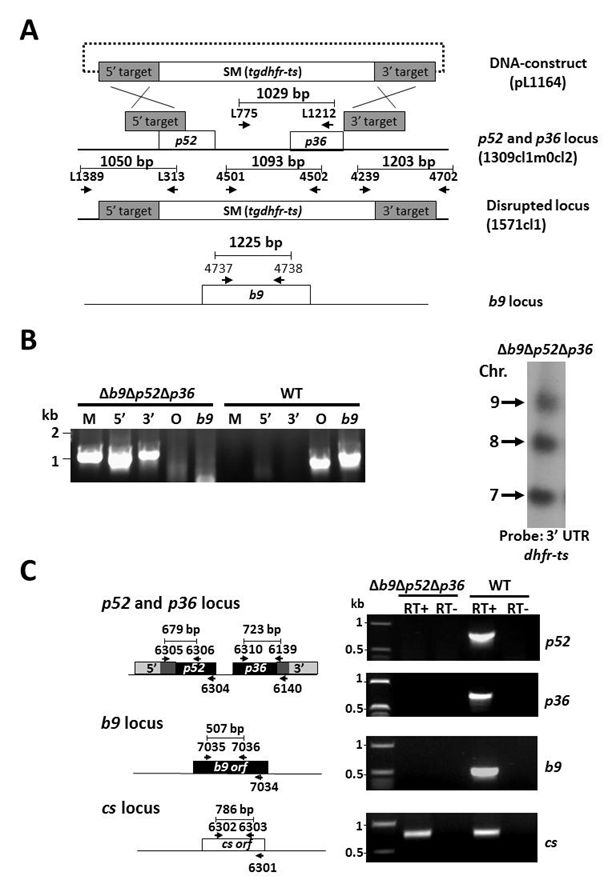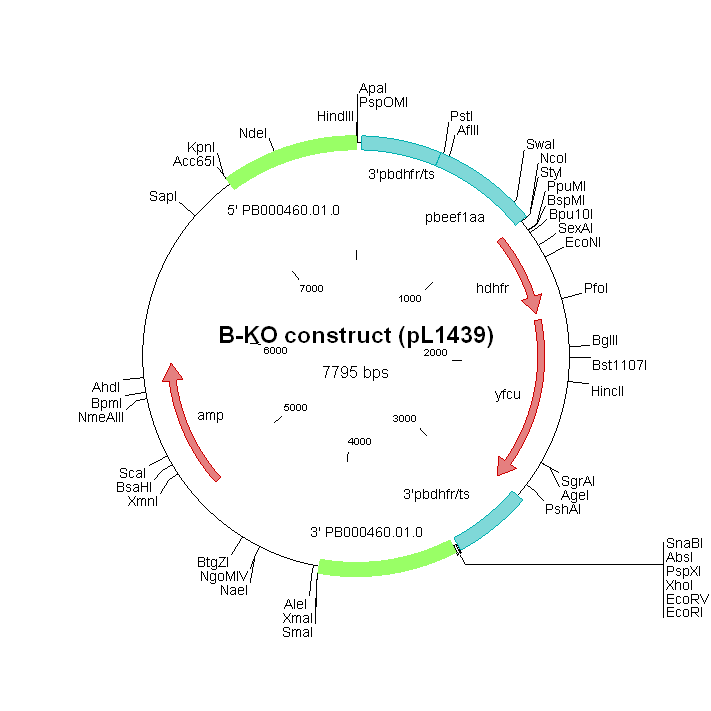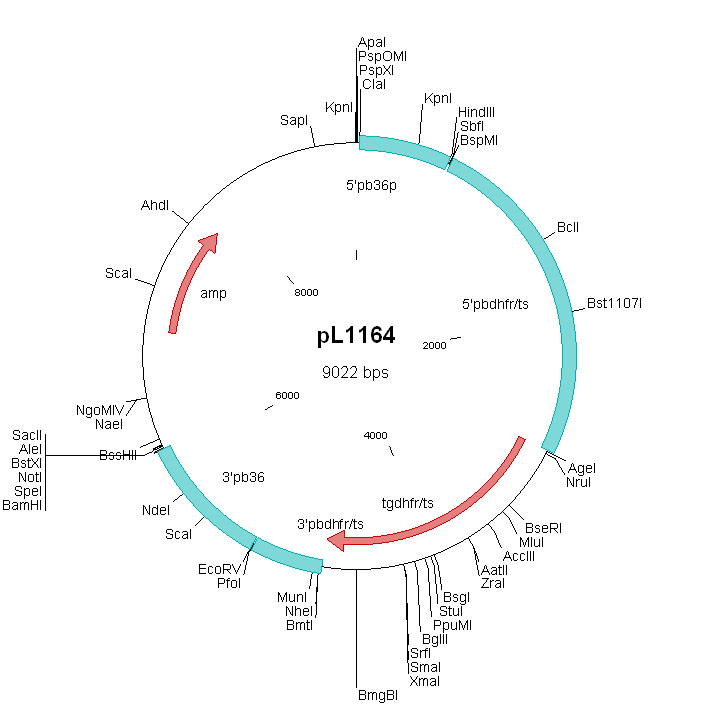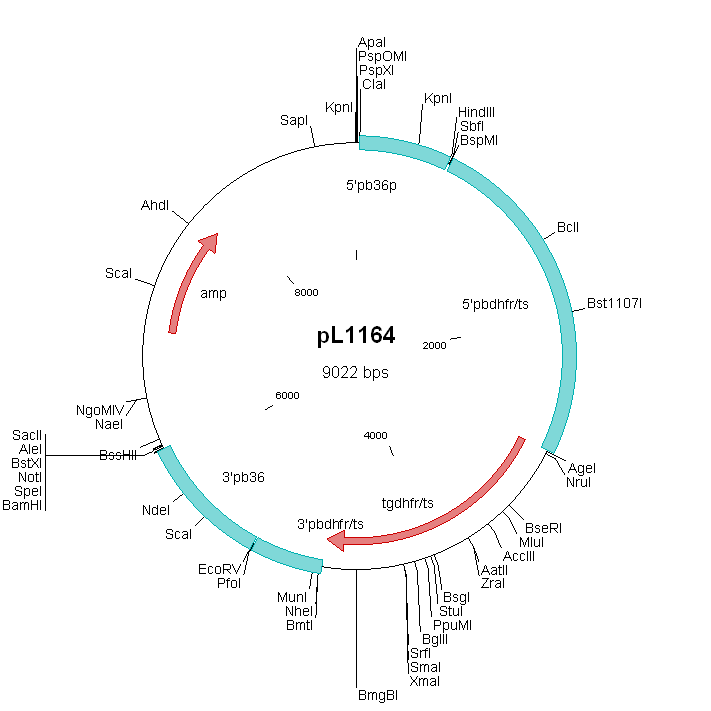SummaryRMgm-935
|
||||||||||||
 *RMgm-935
*RMgm-935| Successful modification | The parasite was generated by the genetic modification |
| The mutant contains the following genetic modification(s) | Gene disruption, Gene disruption, Gene disruption |
| Reference (PubMed-PMID number) |
Reference 1 (PMID number) : 24509910 |
| MR4 number | |
| top of page | |
| Parent parasite used to introduce the genetic modification | |
| Rodent Malaria Parasite | P. berghei |
| Parent strain/line | P. berghei ANKA |
| Name parent line/clone | RMgm-934 |
| Other information parent line | In mutant RMgm-934 the b9 gene is disrupted. The mutant is drug-selectable marker free. |
| top of page | |
| The mutant parasite was generated by | |
| Name PI/Researcher | T. Annoura; S.M. Khan; C.J. Janse |
| Name Group/Department | Leiden Malaria Research Group |
| Name Institute | Leiden University Medical Center (LUMC) |
| City | Leiden |
| Country | The Netherlands |
| top of page | |
| Name of the mutant parasite | |
| RMgm number | RMgm-935 |
| Principal name | 1571cl1 |
| Alternative name | PbΔb9Δp52Δp36 |
| Standardized name | |
| Is the mutant parasite cloned after genetic modification | Yes |
| top of page | |
| Phenotype | |
| Asexual blood stage | Not different from wild type |
| Gametocyte/Gamete | Not different from wild type |
| Fertilization and ookinete | Not different from wild type |
| Oocyst | Not different from wild type |
| Sporozoite | Not different from wild type |
| Liver stage | Gliding motility, hepatocyte traversal and hepatocyte invasion in vitro (HepG2) of mutant sporozoites is similar to wild type sporozoites. Liver stage development is strongly impaired and parasites do not develop into the schizont stage and most invaded parasites cannot be detected anymore at 24 hours after infection. When Swiss or BALB/c mice were infected by intravenous inoculation of either 1 or 5x104 PbΔb9 sporozoites none of the mice developed blood-stage infections. When C57BL6 mice were infected with a high dose of 5x104 PbΔb9 sporozoites, 10-20% developed a blood-stage infection with a 3-4 days prolonged prepatent period. |
| Additional remarks phenotype | Mutant/mutation Supporting Figure S7
|
 Disrupted: Mutant parasite with a disrupted gene
Disrupted: Mutant parasite with a disrupted gene| top of page | |||||||||||||||||||||||||
| Details of the target gene | |||||||||||||||||||||||||
| Gene Model of Rodent Parasite | PBANKA_0808100 | ||||||||||||||||||||||||
| Gene Model P. falciparum ortholog | PF3D7_0317100 | ||||||||||||||||||||||||
| Gene product | 6-cysteine protein | ||||||||||||||||||||||||
| Gene product: Alternative name | B9 | ||||||||||||||||||||||||
| top of page | |||||||||||||||||||||||||
| Details of the genetic modification | |||||||||||||||||||||||||
| Inducable system used | No | ||||||||||||||||||||||||
| Additional remarks inducable system | |||||||||||||||||||||||||
| Type of plasmid/construct used | (Linear) plasmid double cross-over | ||||||||||||||||||||||||
| PlasmoGEM (Sanger) construct/vector used | No | ||||||||||||||||||||||||
| Modified PlasmoGEM construct/vector used | No | ||||||||||||||||||||||||
| Plasmid/construct map |
 | ||||||||||||||||||||||||
| Plasmid/construct sequence |
  AGCTTGGGCCCCCGCGGTGGCGGCCGCTCTAGCTTTGATCCCGTTTTTCTTACTTATATA
| ||||||||||||||||||||||||
| Restriction sites to linearize plasmid | |||||||||||||||||||||||||
| Partial or complete disruption of the gene | Complete | ||||||||||||||||||||||||
| Additional remarks partial/complete disruption | |||||||||||||||||||||||||
| Selectable marker used to select the mutant parasite | hdhfr/yfcu | ||||||||||||||||||||||||
| Promoter of the selectable marker | eef1a | ||||||||||||||||||||||||
| Selection (positive) procedure | pyrimethamine | ||||||||||||||||||||||||
| Selection (negative) procedure | No | ||||||||||||||||||||||||
| Additional remarks genetic modification | The mutant lacks expression of B9 (PBANKA_080810), P36 (PBANKA_100210) and P52 (PBANKA_100220). The genes p36 and p52 are disrupted using a single disruption construct in mutant RMgm-933. In this mutant the b9 gene is disrupted and is drug-selectable marker free. | ||||||||||||||||||||||||
| Additional remarks selection procedure | |||||||||||||||||||||||||
|
Primer information: Primers used for amplification of the target sequences
 Primer information: Primers used for amplification of the target sequences

| |||||||||||||||||||||||||
| top of page | |||||||||||||||||||||||||
 Disrupted: Mutant parasite with a disrupted gene
Disrupted: Mutant parasite with a disrupted gene| top of page | |||||||||||||||||||||||||
| Details of the target gene | |||||||||||||||||||||||||
| Gene Model of Rodent Parasite | PBANKA_1002100 | ||||||||||||||||||||||||
| Gene Model P. falciparum ortholog | PF3D7_0404400 | ||||||||||||||||||||||||
| Gene product | 6-cysteine protein | ||||||||||||||||||||||||
| Gene product: Alternative name | P36 | ||||||||||||||||||||||||
| top of page | |||||||||||||||||||||||||
| Details of the genetic modification | |||||||||||||||||||||||||
| Inducable system used | No | ||||||||||||||||||||||||
| Additional remarks inducable system | |||||||||||||||||||||||||
| Type of plasmid/construct used | (Linear) plasmid double cross-over | ||||||||||||||||||||||||
| PlasmoGEM (Sanger) construct/vector used | No | ||||||||||||||||||||||||
| Modified PlasmoGEM construct/vector used | No | ||||||||||||||||||||||||
| Plasmid/construct map |
 | ||||||||||||||||||||||||
| Plasmid/construct sequence |
  GGGCCCCCCCTCGAGGTCGACGGTATCGATGAATAATAGTAAATGATGAAGCGTCGGAGA
| ||||||||||||||||||||||||
| Restriction sites to linearize plasmid | |||||||||||||||||||||||||
| Partial or complete disruption of the gene | Complete | ||||||||||||||||||||||||
| Additional remarks partial/complete disruption | |||||||||||||||||||||||||
| Selectable marker used to select the mutant parasite | tgdhfr | ||||||||||||||||||||||||
| Promoter of the selectable marker | pbdhfr | ||||||||||||||||||||||||
| Selection (positive) procedure | pyrimethamine | ||||||||||||||||||||||||
| Selection (negative) procedure | No | ||||||||||||||||||||||||
| Additional remarks genetic modification | The mutant lacks expression of B9 (PBANKA_080810), P36 (PBANKA_100210) and P52 (PBANKA_100220). The genes p36 and p52 are disrupted using a single disruption construct in mutant RMgm-933. In this mutant the b9 gene is disrupted and is drug-selectable marker free. | ||||||||||||||||||||||||
| Additional remarks selection procedure | |||||||||||||||||||||||||
|
Primer information: Primers used for amplification of the target sequences
 Primer information: Primers used for amplification of the target sequences

| |||||||||||||||||||||||||
| top of page | |||||||||||||||||||||||||
 Disrupted: Mutant parasite with a disrupted gene
Disrupted: Mutant parasite with a disrupted gene| top of page | |||||||||||||||||||||||||
| Details of the target gene | |||||||||||||||||||||||||
| Gene Model of Rodent Parasite | PBANKA_1002200 | ||||||||||||||||||||||||
| Gene Model P. falciparum ortholog | PF3D7_0404500 | ||||||||||||||||||||||||
| Gene product | 6-cysteine protein | ||||||||||||||||||||||||
| Gene product: Alternative name | P36p; Pb36p; P52 | ||||||||||||||||||||||||
| top of page | |||||||||||||||||||||||||
| Details of the genetic modification | |||||||||||||||||||||||||
| Inducable system used | No | ||||||||||||||||||||||||
| Additional remarks inducable system | |||||||||||||||||||||||||
| Type of plasmid/construct used | (Linear) plasmid double cross-over | ||||||||||||||||||||||||
| PlasmoGEM (Sanger) construct/vector used | No | ||||||||||||||||||||||||
| Modified PlasmoGEM construct/vector used | No | ||||||||||||||||||||||||
| Plasmid/construct map |
 | ||||||||||||||||||||||||
| Plasmid/construct sequence |
  GGGCCCCCCCTCGAGGTCGACGGTATCGATGAATAATAGTAAATGATGAAGCGTCGGAGA
| ||||||||||||||||||||||||
| Restriction sites to linearize plasmid | |||||||||||||||||||||||||
| Partial or complete disruption of the gene | Complete | ||||||||||||||||||||||||
| Additional remarks partial/complete disruption | |||||||||||||||||||||||||
| Selectable marker used to select the mutant parasite | tgdhfr | ||||||||||||||||||||||||
| Promoter of the selectable marker | pbdhfr | ||||||||||||||||||||||||
| Selection (positive) procedure | pyrimethamine | ||||||||||||||||||||||||
| Selection (negative) procedure | No | ||||||||||||||||||||||||
| Additional remarks genetic modification | The mutant lacks expression of B9 (PBANKA_080810), P36 (PBANKA_100210) and P52 (PBANKA_100220). The genes p36 and p52 are disrupted using a single disruption construct in mutant RMgm-933. In this mutant the b9 gene is disrupted and is drug-selectable marker free. | ||||||||||||||||||||||||
| Additional remarks selection procedure | |||||||||||||||||||||||||
|
Primer information: Primers used for amplification of the target sequences
 Primer information: Primers used for amplification of the target sequences

| |||||||||||||||||||||||||
| top of page | |||||||||||||||||||||||||




